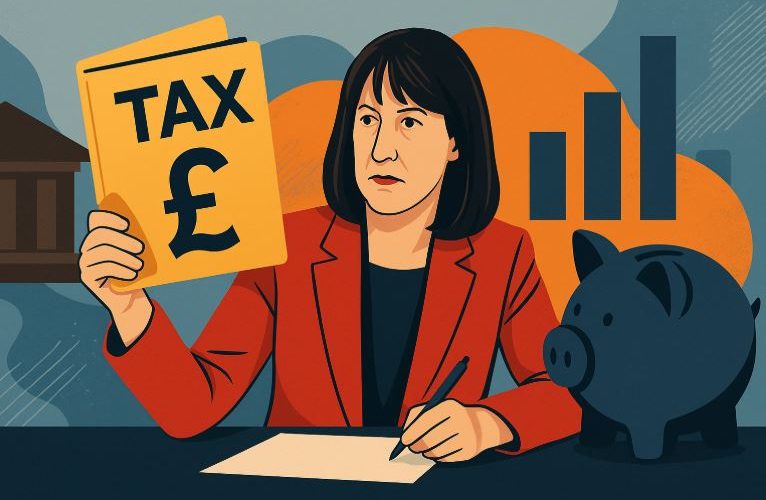In recent months, one of the biggest questions surrounding UK fiscal policy has been the impact of new government tax measures on ordinary savers.
As interest rates rise and more people earn more from their savings, Chancellor Rachel Reeves has moved to tighten HM Revenue & Customs (HMRC)’s ability to track and tax that income.
But what do these changes actually mean for you? And how will the Rachel Reeves tax crackdown on savings accounts reshape how your interest income is reported and taxed?
This blog explores all these questions and more, using up-to-date insights from government statements, leading financial analysts, and major UK news outlets. Let’s unpack the potential implications of this reform in simple, clear terms.
Why Is the Government Targeting Savings Accounts with New Tax Rules?

As the UK grapples with budget shortfalls and inflationary pressures, the government is looking more closely at how interest earned on savings accounts is taxed.
Chancellor Rachel Reeves has backed a significant financial reform designed to close the tax gap and reduce the number of unpaid savings-related tax bills.
This crackdown is not merely a policy suggestion; it is now a confirmed path that will reshape how savings account interest is reported and taxed in the UK.
As part of these changes, banks and building societies will soon be required to collect and share more customer information directly with HM Revenue and Customs (HMRC), including National Insurance numbers.
From April 2027, this new reporting mechanism will take effect, enabling HMRC to accurately match savers’ interest income with tax records.
For many, this means that income from savings will be taxed automatically via the PAYE system, reducing the role of self-assessment.
Why Now?
The shift comes at a time when interest rates have risen sharply, pushing more savers beyond their tax-free savings limits.
HMRC estimates show that 3.35 million people will earn taxable savings income this year, and 2.64 million are expected to receive tax bills, 120,000 more than the previous year.
Until now, much of the interest data HMRC receives has been incomplete. Around 20 percent of this information is unreadable due to missing identifiers. With rising interest rates, this inefficiency has become costly for the Treasury.
How Will Rachel Reeves’ Tax Crackdown on Savings Accounts Affect UK Savers?
The impact of these changes on savers across the UK is expected to be considerable. While some may welcome the efficiency and automation promised by HMRC, others are voicing concerns about privacy, oversight, and possible errors.
Immediate Changes for Savers
Starting in 2027, those with savings accounts will need to provide their National Insurance numbers to banks. This requirement applies to both new and existing accounts.
With this information, HMRC will be able to accurately assess how much tax is owed without relying on self-reported figures via self-assessment.
Long-Term Implications
Savers will likely see a reduction in their take-home pay if their savings interest exceeds the personal allowance thresholds. Rather than waiting for a separate tax bill, the amount owed will be deducted automatically from pay packets.
However, critics have raised the issue of clarity. With automated deductions, taxpayers may not always know what they’re paying or whether the amount is correct.
According to the Low Income Tax Reform Group and the Association of Taxation Technicians, HMRC should present savings data in a clearer and more digestible format for transparency and accuracy.
What Changes Are Being Made to Bank Reporting Requirements?

Under the new rules, banks will play a more central role in tax collection related to savings interest. Their responsibilities are expanding, and they will be required to upgrade systems to manage the additional data collection.
National Insurance Numbers Become Mandatory
From 2027, any customer holding or opening a savings account must supply their National Insurance number. This identifier will help HMRC accurately map interest payments to individual tax records.
Who Will Not Be Affected Immediately?
Customers applying for current accounts will not be required to provide this information initially. However, HMRC has not ruled out extending the requirement in the future.
Increased Cost for Banks
The government has estimated the reform will cost HMRC approximately £35 million. Banks are expected to bear even greater costs, up to £10 million per institution, to meet the administrative requirements, especially for older accounts.
Only around 10 percent of customers respond to official correspondence, making the implementation process slower and more resource-intensive.
Could Rachel Reeves Tax Crackdown On Savings Accounts Impact Lower-Income Savers?
There are growing concerns that the tax changes could disproportionately affect individuals on lower incomes, especially those who may not be aware of their rights or how much interest they are earning.
Tax Liability and the PSA Threshold
Lower-income individuals, while more likely to remain under the personal savings allowance, could still be impacted if interest rates continue to rise.
A basic-rate taxpayer can earn up to £1,000 interest tax-free, but this limit can be easily exceeded with high-yield accounts and larger savings.
Children and the National Insurance Gap
A key issue raised during consultations is that children under 16, who do not have National Insurance numbers, can hold savings accounts. This creates uncertainty about how their savings will be reported and taxed under the new rules.
Risks of Over-Taxation
Automated tax assessments without proper explanation can result in taxpayers paying more than they owe. Experts recommend keeping accurate records of your interest earnings and verifying any deductions with HMRC’s estimates.
Is Your Personal Savings Allowance at Risk Under the New Rules?

Your Personal Savings Allowance (PSA) remains unchanged under the new rules, for now. However, as reporting improves and more data becomes available to HMRC, more people will find themselves liable for tax on interest income they might not have previously declared.
Current PSA Limits
| Tax Band | Personal Savings Allowance | Example Interest Earned | Taxable Amount | Tax Rate | Annual Tax Due |
| Basic Rate (20%) | £1,000 | £1,500 | £500 | 20% | £100 |
| Higher Rate (40%) | £500 | £1,500 | £1,000 | 40% | £400 |
| Additional Rate (45%) | £0 | £1,500 | £1,500 | 45% | £675 |
What Happens Above These Limits?
Any interest earned above your allowance will be taxed at your income tax rate. HMRC will usually update your PAYE tax code accordingly, so the amount owed is automatically deducted from your income.
What Role Will National Insurance Numbers Play in HMRC’s New Strategy?
National Insurance numbers will become the linchpin of HMRC’s new data-matching system. With better data comes better enforcement, and that’s exactly what the government is aiming for.
Solving Data Gaps
Currently, up to 20 percent of interest data submitted by banks is unreadable or unmatchable with tax records. This is primarily due to missing identifiers. By mandating NI numbers, HMRC expects to significantly reduce these errors.
Direct Tax Collection via PAYE
Rather than relying on taxpayers to submit self-assessments, HMRC will calculate taxes owed and apply them automatically through the PAYE system.
This reduces the chances of underpayment but increases the risk of taxpayers not understanding their deductions.
How Might the PAYE System Be Used to Collect Savings Tax Automatically?
The PAYE system will be leveraged more heavily than ever to collect tax on savings. Once HMRC matches your savings interest to your National Insurance number, they can adjust your tax code accordingly.
A Shift from Self-Assessment
Only individuals with complex financial arrangements or additional untaxed income will need to file a self-assessment. The majority of taxpayers will see deductions made seamlessly through their pay.
Long-Term Monitoring
HMRC has the authority to backdate tax assessments up to four years, or six in cases of negligence. If deliberate evasion is suspected, assessments can reach back 20 years. This makes accurate reporting even more critical for taxpayers.
What Are the Concerns from Banks and Financial Institutions?

Financial institutions have been vocal in expressing concern about the feasibility and fairness of the new reporting requirements.
Administrative Burden
Retail banks warn that the changes represent a massive administrative overhaul, particularly for legacy accounts. Implementing systems that can collect, store, and share NI data accurately is not only time-consuming but expensive.
Customer Compliance
Getting customers to respond and supply their NI numbers is another challenge. With historically low response rates to letters and notifications, many banks fear they will not be able to achieve full compliance by the 2027 deadline.
Risk to Customer Relationships
There is a risk that customers may feel targeted or mistrust their financial institutions due to the new data-sharing policies. Clear communication and education will be essential to maintaining customer trust.
Could This Crackdown Be Seen as Government Overreach?
The growing involvement of HMRC in personal savings has prompted concerns from political and financial figures about the extent of state surveillance.
Political Criticism
Former Conservative cabinet minister Sir David Davis has criticised the move as excessive state intrusion, suggesting it undermines financial privacy and personal freedom.
Legal Safeguards and Transparency
Advocacy groups are calling for HMRC to be transparent about how data is used and ensure taxpayers have access to clear and understandable breakdowns of their tax liabilities.
How Can Savers Protect Themselves from Errors and Unexpected Tax Bills?
While the new rules are intended to streamline tax collection, they also place responsibility on savers to monitor their finances more closely.
Practical Steps
- Use ISAs: Interest in Individual Savings Accounts (ISAs) is not taxable under current rules.
- Split Savings Across Households: Spreading savings across multiple family members can help maximise PSA usage.
- Track Your Interest Manually: Keep records and compare them to what HMRC reports.
- Fix Rates Early: Consider locking into fixed-term savings products before the rules come into force.
Conclusion
Rachel Reeves’ tax crackdown on savings accounts marks a major shift in how the UK government handles personal interest income. While the move aims to simplify tax collection and close revenue gaps, it introduces complex challenges for banks and savers alike.
From 2027, expect tighter data controls, automatic deductions via PAYE, and less reliance on self-assessment. The changes are driven by a broader effort to improve HMRC’s ability to collect accurate data, ensure fairness, and increase transparency.
As this policy develops, staying informed and proactive is crucial. Understanding your tax obligations now can prevent unwelcome surprises in the years to come.
FAQs
How is savings interest currently reported to HMRC?
Banks report annual interest to HMRC, but the lack of National Insurance numbers has made a portion of the data incomplete or unusable.
Will I still need to do a self-assessment for savings tax?
Most taxpayers won’t need to file a self-assessment solely for savings. However, if you have multiple income sources or complex finances, you may still need to file one.
Can children’s savings accounts be taxed?
Yes, although it’s complex. Children under 16 don’t have NI numbers, which makes reporting difficult. HMRC is considering solutions.
Do joint accounts get two allowances?
Yes, the interest is typically divided equally between both account holders, and each can apply their own PSA.
Can I avoid the crackdown by moving savings abroad?
No. Overseas savings must be declared. Hiding them from HMRC is illegal and could result in serious penalties.









